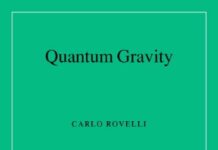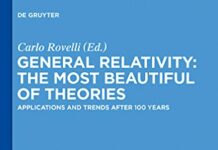
Ebook Info
- Published: 2016
- Number of pages: 88 pages
- Format: PDF
- File Size: 1.76 MB
- Authors: Carlo Rovelli
Description
The New York Times bestseller from the author of The Order of Time and Reality Is Not What It Seems, Helgoland, and Anaximander“One of the year’s most entrancing books about science.”—The Wall Street Journal“Clear, elegant…a whirlwind tour of some of the biggest ideas in physics.”—The New York Times Book Review This playful, entertaining, and mind-bending introduction to modern physics briskly explains Einstein’s general relativity, quantum mechanics, elementary particles, gravity, black holes, the complex architecture of the universe, and the role humans play in this weird and wonderful world. Carlo Rovelli, a renowned theoretical physicist, is a delightfully poetic and philosophical scientific guide. He takes us to the frontiers of our knowledge: to the most minute reaches of the fabric of space, back to the origins of the cosmos, and into the workings of our minds. The book celebrates the joy of discovery. “Here, on the edge of what we know, in contact with the ocean of the unknown, shines the mystery and the beauty of the world,” Rovelli writes. “And it’s breathtaking.”
User’s Reviews
Reviews from Amazon users which were colected at the time this book was published on the website:
⭐Back in the day, when I was a young lad and setting out on a pre-med course at the University of Michigan, I gravitated toward the sciences. I was even pretty good at the stuff, if the grades I received were any indication. In fact, very good. I routinely received the top grade in a huge freshman lecture course in chemistry. And I remember taking a physics course as well that year; even though I never attended a single lecture — they were held at the completely unreasonable hour of 8:00 am, after all — and I studied for only a day or two before the final exam, I managed to receive an A. (Only later did problems emerge when I was forced to enter chemistry and zoology lab, where I proved to be a first-class klutz.) You might think that this would indicate an ability on my part to understand at least a little of physics today.No such luck.Physics today is not what it used to beNow here comes the brilliant Italian physicist Carlo Rovelli with a bestselling book titled Seven Brief Lessons on Physics. Compiled from a series of newspaper columns in his native Italy, the book was such a breakaway bestseller there that it even outsold the Shades of Gray novels! It’s tiny, the length of a novella — 96 pages in its American hardcover edition — so the book is meant to be read (and presumably understood) at a single sitting.The “Lessons” describe six principal milestones in twentieth-century physics. This is Rovelli’s attempt to put contemporary physics in context. He places our growing understanding of the physical universe on a continuum that started when the Greeks first brought intellectual firepower to bear on the biggest questions humankind can ask. Individual chapters cover Relativity Theory, Quantum Theory, cosmology, particle physics, the clash between relativity and quantum mechanics, and the character of black holes. A seventh chapter deals with “Ourselves,” an often poetic effort to dissect the meaning of all this learning for our lives as individuals and as a civilization.“Seven Lessons” meant to explain may only confuseEnough has been written about the topic of relativity that it’s possible for an educated reader to know the rudiments of the theory. Understanding it is something else. After all, what does it mean that space and time are curved? Beats me.Quantum mechanics are even more impenetrable for a layperson — at least, this layperson — to grasp. A popular version of Heisenberg’s Uncertainty Principle is familiar, of course — but just try to understand what even that really means, let alone the original version, which is impenetrable. Taken to its logical conclusion, “reality is only interaction,” as Rovelli explains. Come again?When I studied physics and chemistry more than half a century ago, I was taught that protons, electrons, and neutrons were the basic building-blocks of the atoms that had previously been thought to be the fundamental particles of all matter. Now physics teaches us that “electrons, quarks, photons, and gluons are the [even tinier] components of everything that sways in the space around us” — not to mention our own bodies. Here’s Rovelli again: “Quantum mechanics and experiments with particles have taught us that the world is a continuous, restless swarming of things, a continuous coming to light and disappearance of ephemeral entities. A set of vibrations, as in the switched-on hippie world of the 1960s. A world of happenings, not of things.” Does that make it all any clearer?Just in case you think this all fits together into a neat picture of the physical reality we all experience, listen: “There’s a paradox at the heart of our understanding of the physical world. The twentieth century gave us the two gems of . . . general relativity and quantum mechanics.” These two theories lie at the base of all our understanding today. “And yet the two theories cannot both be right, at least in their current forms, because they contradict each other.” Rovelli himself is an advocate of one of several current theories that attempt to close the gap between general relativity and quantum mechanics. It’s called “loop quantum gravity theory.” And, even after Rovelli’s attempt to explain it in practical terms, it makes absolutely no sense whatsoever to my untutored mind.A recurring theme in Seven Lessons is that reality isn’t what it appears to be, so far as physicists are concerned. For example, “due to the limitations of our consciousness we perceive only a blurred vision of the world and live in time. To borrow words from my Italian editor, ‘what’s non-apparent is much vaster than what’s apparent.’”Rovelli is at best when he brings his argument down to Earth, so to speak. “When we say that we are free,” he writes, “and it’s true that we can be, this means that how we behave is determined by what happens within us, within the brain, and not by external factors. To be free doesn’t mean that our behavior is not determined by the laws of nature. It means that it is determined by the laws of nature acting in our brains. . . Our moral values, our emotions, our loves are no less real for being part of nature, for being shared with the animal world, or for being determined by the evolution that our species has undergone over millions of years. . . Our reality is tears and laughter, gratitude and altruism, loyalty and betrayal, the past that haunts us and serenity. Our reality is made up of our societies, of the emotion inspired by music, of the rich intertwined networks of the common knowledge that we have constructed together. All of this is part of the self-same ‘nature’ that we are describing.”In other words, reality is what we make of it, physics be damned.About the authorThe Italian theoretical physicist Carlo Rovelli currently works in France. He specializes in the field of “quantum gravity” and is one of the founders of a theory that attempts to reconcile general relativity with quantum mechanics.
⭐It’s Not What You ThinkBy Bob Gelms I have two science books that, over the years, have become my favorites, The Elegant Universe and The Field. I have just found a third, Carlo Rovelli’s Seven Brief Lessons on Physics. Keep reading, it’s not what you think.First of all I have to tell you that there isn’t any math in the book. There is one equation that Mr. Rovelli prints just to show you what it looks like. It’s not very famous unless you are already a physicist. In the preface he states, “These lessons were written for those who know little or nothing about modern science. Together they provide a rapid overview of the most fascinating aspects of the great revolution that has occurred in physics in the twentieth and twenty first century…” In the spirit of Mr. Rovelli’s book, physics is the concrete explanation of the magic of the universe. It is the search for the truth about how everything in the universe operates interdependently on a grand scale (galaxies) and on the minute scale (electrons, protons, neutrons, quarks, gluons, etc.) This search, at times, has been fraught with the real danger of losing your life. Galileo was almost burned at the stake, commuted to life imprisoned under house arrest, for simply saying that the Earth revolved around the Sun. Scientists in the twentieth century are a little better off. The book is very short. If you have the print version, it’s 81 pages long, with only seven chapters called lessons. It starts at the beginning of the twentieth century with, next to Isaac Newton, the most important physicist in all of history, Albert Einstein. Einstein’s theories are simply and elegantly explained in plain non-scientific language. The culmination of his work is called A General Theory of Relativity, in addition to three or four other papers that were glossed over and initially laughed at.Once the scientific community caught up with Einstein’s brain they were struck dumb with the beauty and simplicity of his vision for the operation of the universe. It has always struck me curious that when he won the Nobel Prize it wasn’t for relativity (E=MC2). It was for one of those glossed over papers on the nature of light. He did all of his work on relativity and the photoelectric effect in 1905, when he was 26 years old. Over the years, he became a towering giant in the history of science while remaining a gentle and kind man. The second lesson covers the exact opposite of Einstein’s theories. Planck, Bohr, and Heisenberg all contributed in some degree to the theory of the littlest “things” in the universe, which came to be called quantum mechanics. It deals with atoms and the particles that make them up, showing how they interact with the ever-changing landscape around and in them. Then all hell broke loose.It seems that the rules and regs that describe perfectly Einstein’s big universe of galaxies, stars, solar systems and planets do not work if you apply those rules and regs to the little world of quantum mechanics. Conversely if you take the rules and regs of the little universe of quantum mechanics and apply them to Einstein’s big universe you will find that they don’t work. WELL. Both theories contradict one another and they shouldn’t because they both work perfectly in their own space and time. The big prize in physics these days is to find the link between the two because it is inherent in both theories that there be something that draws them together. Einstein called it the unified field theory and he tried to find it his whole life. He failed. Lessons One, Two and Seven are the far and away the most interesting and most important in the book. The other essays cover more popular topics like time, black holes, probability, particles, and a lesson called Grains of Space which is a brief explanation of a theory founded by Mr. Rovell, himself a theoretical physicist. In it, he attempts, I think, to reconcile the big with the small worlds of physics. It is called loop quantum gravity and it’s where general relativity meets quantum mechanics. In many ways the most interesting of all the essays is the last one. It’s simply called Ourselves. This is where Mr. Rovelli attempts to equate us, homo sapiens, to the interworking of the universe. We are all made of stardust put together using the immutable laws of nature. Our bodies conform to how the atoms we are made of obey quantum mechanics and the way in which we pass through time and space. It is utterly fascinating. I had an “oh wow” moment. I’d like to close with Mr. Rovelli’s words. “Here, on the edge of what we know, in contact with the ocean of the unknown, shines the mystery and the beauty of the world. And it’s breathtaking.”
⭐This book will make you fall in love with physics. Rovelli’s poetic style takes you on a magical journey to a universe so close to us and yet so far. A must read!
⭐The amazing talent to take the reader through the double slit experiment, the though experiments and all the development of improvements in experimental technique made me think that this very short work would be equally spellbinding, full of information told in a new way, but after reading it once and browsing through it on a second reading, I came up short in being able to even summarize why the book was written.I’ll give it another read in a few months, but this almost seems to have been written by an entirely different author altogether. Oh well, the lending library will get it after I’m done. This isn’t of enough value to occupy a spot on my shelf.
⭐Rovelli makes physics not only accessible but enchanting. I understood enough to be fascinated and to want to learn more about this magical mathematical field. Recommend for all different types of audiences.
⭐Book arrived earlier than expected. Perfect condition. I highly recommend this seller.
⭐Top physicist and excellent writer simply explains the state of play in contemporary science.
⭐A very brief book packed with a punch. I recently hear Carlo on BBC Radio 2, he gave such a freat interview that I felt I MUST buy this book. As fellow reviewers have noted Seven Brief lessons is, given the subject matter, very easy to follow and grasp – it does stimulate you to read further and I’ve already watched other on-line tutorials depicting and explaining topics such as Gravity wells .Reading this book has opened so many other doors to this amazing universe.
⭐We are used to the billions and trillions narrative of today’s physics PR and the eternal promise that just a few more Billion dollars, accelerators and Noble prizes and the atheists will celebrate the God particle or the reverse string loop de loop theory whatever lastest nonsense!The truth is science is busy deconstructing ‘knowledge’ it describes to a few with esoteric mathematics and calls it an explanation!The real wonder is consciousness, the ‘I’ the you, the everything made from soil from the stars! Our science is a monkey pointing at the moon!
⭐This is a short, pocket-sized overview of seven physics theories, ranging from Albie Einstein and his relativities to the rather more barking mad world of quantum theory. You’d think that a book that has less than 100 pages wouldn’t have much depth to it and would be fairly easy to understand,(fun to read, even) but Ravelli has managed to make the subject as dull as dishwater, and just as clear. And he also gets very preachy and melodramatic towards the end when talking about climate change.I enjoyed his recent “Helgoland”, a work which is ironically denser in parts, so thought I’d give this a whirl due to the plaudits it has received. Sadly, unlike Benedict Cumberbatch, I won’t be dipping into this volume again.
⭐Not a lot here for the kindle price of £5 i felt. The last and longest chapter is barely about physics at all from what i remember of it. The first few chapters are ok but then the 5th / 6th are a long the lines of “its still so complicated not even we know” so how enlightening its going to be for a layman who knows. 1st to 4th are ok but just touch the surface.
⭐Put simply, this is a brilliant book and I would urge anyone with even a passing curiosity about the world/space in which we live to read it. It only takes an hour or so, so there’s really no excuse.As I’m sure is true with most people, the science behind the origins of the universe, quantum mechanics etc are largely beyond me. However, Rovelli does a great job of breaking ludicrously complicated subjects into manageable, bite-sized chapters, each of which makes you think a little bit harder about what you thought you knew.
Keywords
Free Download Seven Brief Lessons on Physics in PDF format
Seven Brief Lessons on Physics PDF Free Download
Download Seven Brief Lessons on Physics 2016 PDF Free
Seven Brief Lessons on Physics 2016 PDF Free Download
Download Seven Brief Lessons on Physics PDF
Free Download Ebook Seven Brief Lessons on Physics




